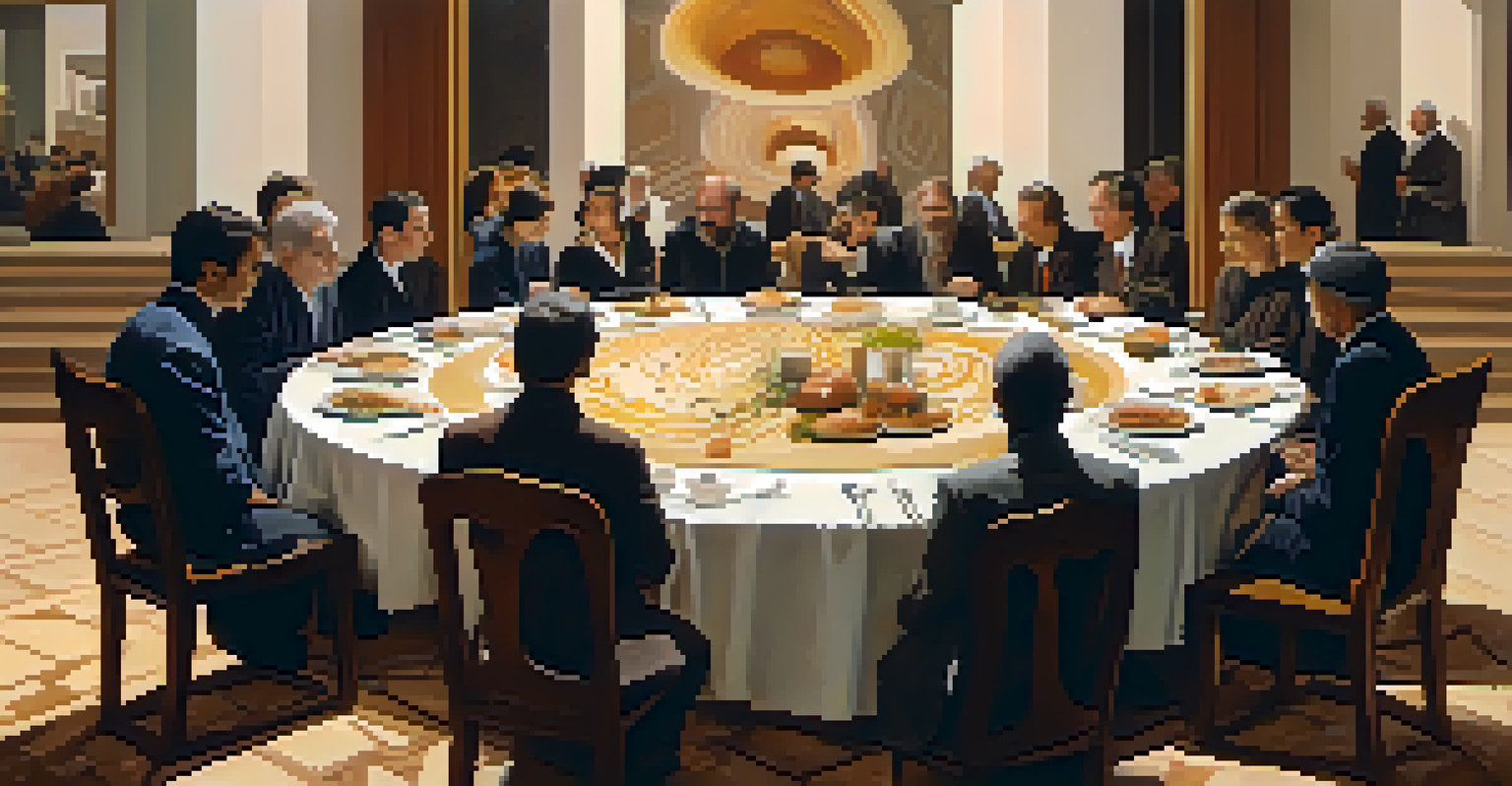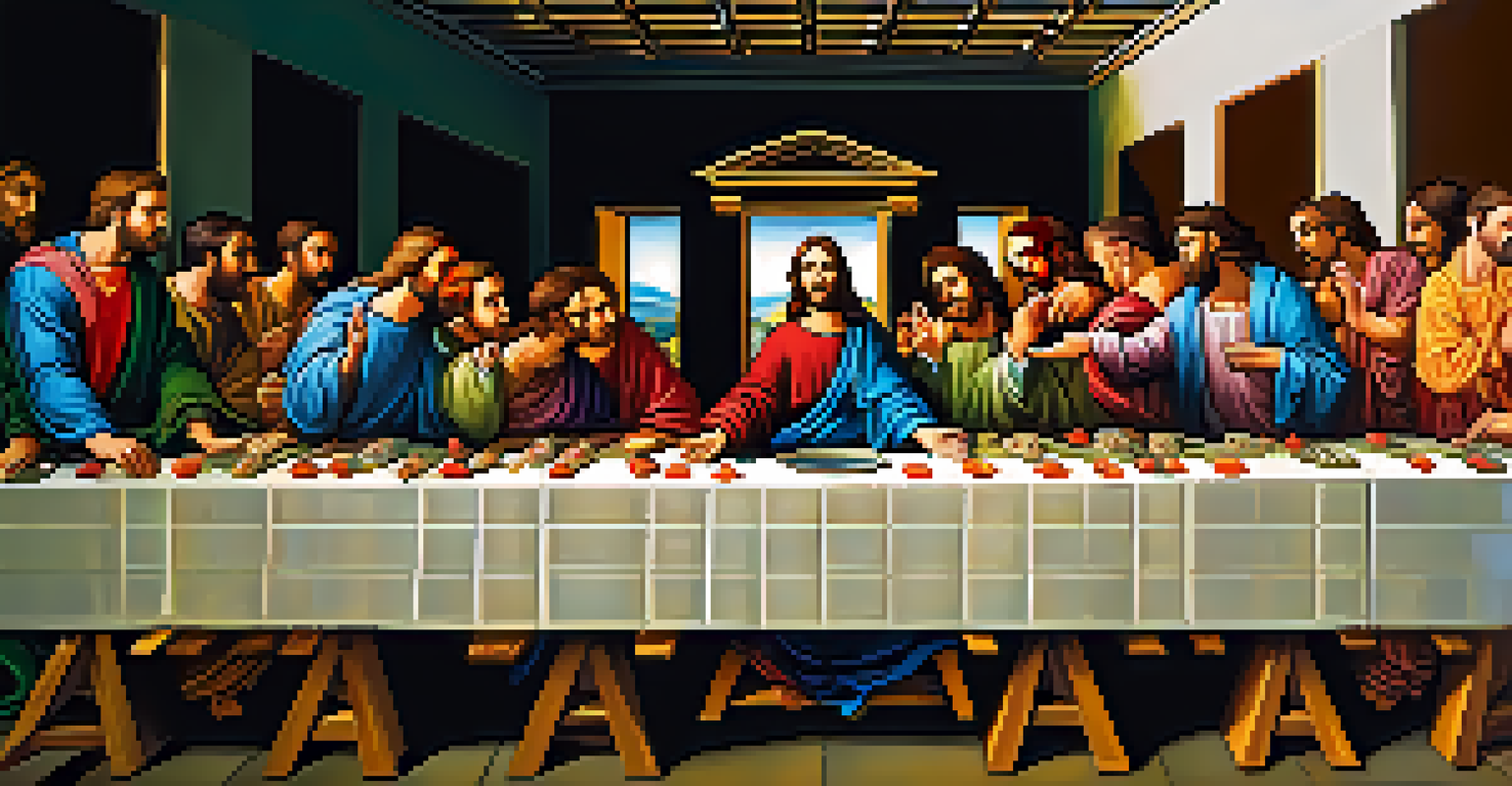Cultural Significance of Time in Religious Art Forms

The Concept of Time in Religious Contexts
Time is a fundamental aspect of many religious beliefs, often viewed as a linear or cyclical experience. For instance, in Christianity, time is seen as a journey from creation to redemption, while in Hinduism, it is perceived as cyclical, with the endless cycles of birth and rebirth. This conceptualization of time heavily influences religious narratives and artistic expressions, shaping how themes like creation, salvation, and enlightenment are depicted.
Time is a created thing. To say 'I don't have time,' is like saying, 'I don't want to.'
Artists often draw upon these varying interpretations of time to convey deeper spiritual meanings in their work. A painting that illustrates a moment of divine intervention, for example, captures the significance of 'now' in relation to eternity. By focusing on specific moments, artists invite viewers to ponder the relationship between time and the spiritual realm.
Understanding these differing views of time enhances our appreciation of religious art forms. It allows us to see not just the aesthetic qualities, but also the profound messages that artists aim to communicate about existence, faith, and eternity.
Symbolism of Time in Different Religions
In many religious art forms, symbols of time often hold significant meaning. For instance, the hourglass can represent the transience of life in Christian art, while in Buddhist art, the lotus flower symbolizes the unfolding of time and spiritual awakening. These symbols serve as reminders of the impermanence of worldly existence and the eternal nature of the divine.

Additionally, various cultures use specific colors and shapes to represent time. In Islamic art, geometric patterns are frequently used to symbolize the infinite nature of time, reflecting the belief in a timeless God. Such symbols resonate deeply with followers, offering visual cues that enhance their spiritual experience.
Time's Spiritual Significance in Art
Different religions interpret time uniquely, influencing how artists convey themes of creation, salvation, and enlightenment.
By examining these symbols, we can gain insight into how different cultures perceive time and its relationship to the divine. This understanding not only enriches our interpretation of religious art but also fosters a greater appreciation for the diversity of human spirituality.
Historical Perspectives on Time in Religious Art
Throughout history, the depiction of time in religious art has evolved significantly. In medieval Europe, for example, artists often illustrated biblical events in a timeless manner, focusing on the spiritual significance rather than chronological accuracy. This approach reflected the belief that God's time transcends human understanding, emphasizing the eternal nature of divine events.
Art is the most beautiful of all lies; it is a representation of reality transformed through the lens of time.
Conversely, the Renaissance period marked a shift towards a more realistic portrayal of time, with artists like Leonardo da Vinci incorporating perspective and naturalism into their work. This change allowed viewers to relate more closely to the divine narratives, bridging the gap between the sacred and the mundane.
These historical shifts illustrate how the cultural significance of time in religious art has continually adapted to reflect changing beliefs and artistic styles. Understanding this evolution helps us appreciate the dynamic interplay between culture, spirituality, and artistic expression.
Time as a Narrative Device in Religious Art
Time often serves as a crucial narrative device in religious art, shaping the storytelling aspect of visual works. Artists frequently depict biblical stories or mythological events in a sequential manner, guiding viewers through a visual journey. This technique helps to communicate complex theological concepts in a relatable way.
For instance, the Last Supper by Leonardo da Vinci captures a pivotal moment in Christian theology, illustrating the tension and anticipation of the events to follow. The use of light, composition, and expression all convey a sense of urgency and significance tied to that specific moment in time.
Rituals Shape Artistic Expressions
The connection between rituals and time in religious art highlights the communal aspects of worship and the significance of tradition.
By understanding how time functions as a narrative device, we can better appreciate the artist's intention and the impact of their work on the viewer's spiritual experience. It invites us to engage more deeply with the stories being told and the lessons they impart.
The Role of Rituals and Time in Religious Art
Rituals often intertwine with concepts of time, creating a unique dynamic in religious art. Many religious ceremonies are tied to specific times of the year, such as Christmas or Ramadan, and these occasions are frequently depicted in art. This connection highlights the significance of time in shaping collective religious experiences.
Artists may capture these rituals in their work, illustrating the communal aspects of worship and the cyclical nature of religious observance. For example, paintings of the Passover Seder reflect the importance of historical memory and tradition, emphasizing the significance of time in the Jewish faith.
By exploring the intersections of rituals and time in religious art, we gain insight into how communities express their beliefs and values. This understanding fosters a deeper appreciation for the role of art in preserving and communicating cultural traditions.
Modern Interpretations of Time in Religious Art
In contemporary religious art, artists continue to explore and reinterpret the concept of time in innovative ways. Many modern works challenge traditional depictions, using abstract forms and mixed media to express the fluidity of time. This approach reflects the complexities of modern spirituality and the diverse experiences of faith.
For instance, some artists may incorporate technology, such as digital media, to represent time as an ever-changing phenomenon. This can evoke reflections on how digital culture influences our perception of time and spirituality in today's fast-paced world.
Cultural Context Influences Time Depiction
Cultural backgrounds significantly affect how time is represented in religious art, showcasing diverse beliefs and practices.
By examining modern interpretations of time in religious art, we can appreciate how artists are pushing boundaries and inviting dialogue about the nature of faith in a contemporary context. This exploration enriches the ongoing conversation about spirituality and artistic expression.
The Impact of Cultural Context on Time in Religious Art
Cultural context plays a vital role in shaping how time is represented in religious art. Different cultures have unique historical narratives and spiritual beliefs that influence how time is understood and depicted artistically. For example, Indigenous art often reflects a deep connection to the land and ancestral time, capturing a sense of continuity and relationship with nature.
Similarly, in African art, time is often represented through storytelling and ancestral connections, emphasizing the importance of heritage and community. These cultural perspectives enrich the conversation about time, illustrating how it is not a universal concept but rather shaped by specific beliefs and practices.

By recognizing the impact of cultural context on the depiction of time in religious art, we can foster greater appreciation for the diversity of artistic expressions. This understanding encourages us to explore how various cultures interpret and represent spiritual narratives.